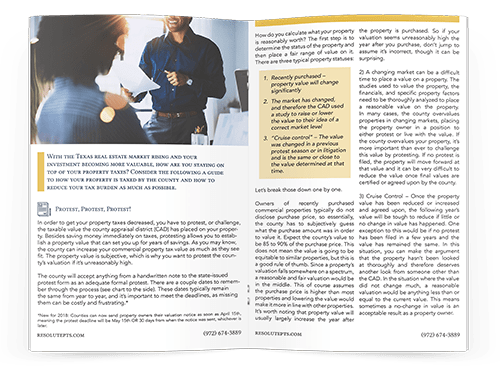Preview: Commercial Tax Whitepaper
Below you will see an excerpt of our whitepaper on commercial property taxes, written by our
managing partner Blake Watterson.
Click here to download the full PDF.
With the real estate market rising and your investment becoming more valuable, how are you
staying on top of your property taxes? Consider the following a guide to how your property is
taxed by the county and how to reduce your tax burden as much as possible.
Protest, Protest, Protest!
In order to get your property taxes decreased, you have to protest, or challenge, the taxable value
the county appraisal district (CAD) has placed on your property. Besides saving money immediately
on taxes, protesting allows you to establish a property value that can set you up for years of
savings. As you may know, the county can increase your commercial property tax value as much as they
see fit. The property value is subjective, which is why you want to protest the county’s valuation
if it’s unreasonably high.
The county will accept anything from a handwritten note to the state-issued protest form as an
adequate formal protest. There are a couple dates to remember through the process
These dates typically remain the same from year to year, and it’s important to meet the deadlines,
as missing them can be costly and frustrating.
How do you calculate what your property is reasonably worth? The first step is to determine the
status of the property and then place a fair range of value on it. There are three typical property
statuses:
- Recently purchased – property value will change significantly
-
The market has changed, and therefore the CAD used a study to raise or lower
the value to their idea of a correct market level
-
"Cruise control" – The value was changed in a previous protest season or in litigation and
is the same or close to the value determined at that time.
Let’s break those down one by one.
Owners of recently purchased commercial properties typically do
not disclose purchase price, so essentially, the county has to subjectively guess what the purchase
amount was in order to value it. Expect the county’s value to be 85% to 90% of the purchase price.
This does not mean the value is going to be equitable to similar properties, but this is a good rule
of thumb. Since a property’s valuation falls somewhere on a spectrum, a reasonable and fair
valuation would be in the middle. This of course assumes the purchase price is higher than most
properties and lowering the value would make it more in line with other properties. It’s worth
noting that property value will usually largely increase the year after the property is purchased.
So if your valuation seems unreasonably high the year after you purchase, don’t jump to assume it’s
incorrect, though it can be surprising.
A changing market can be a difficult time to place a value on a
property. The studies used to value the property, the financials, and specific property factors need
to be thoroughly analyzed to place a reasonable value on the property. In many cases, the county
overvalues properties in changing markets, placing the property owner in a position to either
protest or live with the value. If the county overvalues your property, it’s more important than
ever to challenge this value by protesting. If no protest is led, the property will move forward at
that value and it can be very difficult to reduce the value once values are certified or agreed
upon by the county.
Cruise Control – Once the property value has been reduced or
increased and agreed upon, the following year’s value will be tough to reduce if little or no change
in value has happened. One exception to this would be if no protest has been led in a few years and
the value has remained the same. In this situation, you can make the argument that
the property hasn’t been looked at thoroughly and therefore deserves another look from someone
other than the CAD. In the situation where the value did not...
There's much more where that came from!
Click here to download the full PDF.

